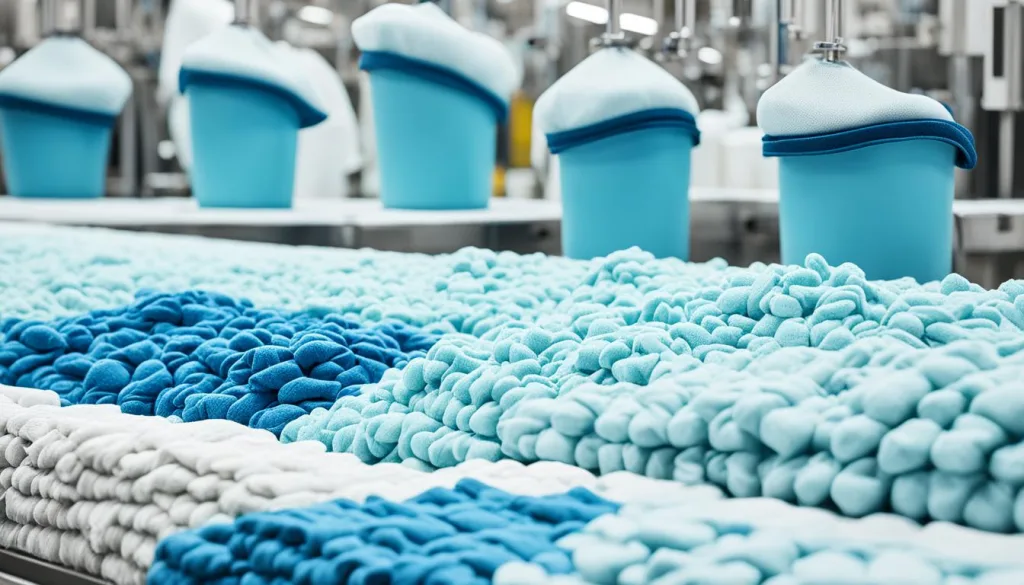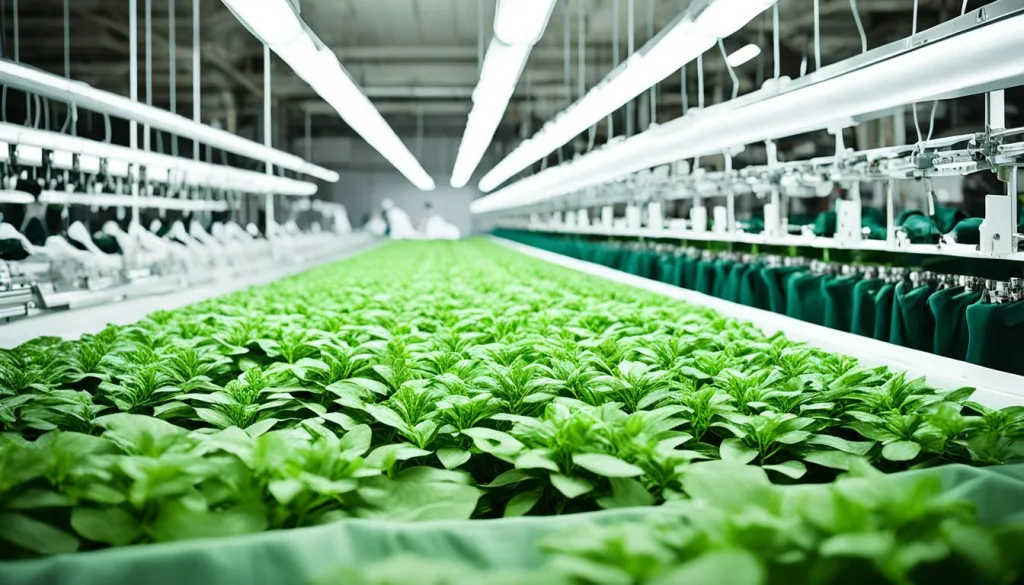Compliance with Global Chemical Restrictions in Apparel Production
Connect With Us Today
Consider us for your next production run. Why wait? Send us your questions here.
Today, the apparel industry stands at a key juncture. It’s all about balancing innovation with strict apparel chemical regulations. The push for chemical protective clothing (CPC) comes from ISO and CEN. This shows the need for apparel industry compliance with tight global rules1. Manufacturers have a big task. They must make sure their products are eco-friendly and meet high standards.
This is also about living up to what consumers and stakeholders expect. They want products that are safe for the environment and for people. Meeting these expectations is vital for the industry’s future.
Key Takeaways
- Knowing about apparel chemical regulations is key for staying in line with the law.
- Following ISO and CEN standards is very important for making textiles that don’t harm the planet.
- Wearing protective clothing isn’t just following rules. It’s about keeping the industry sustainable and responsible1.
- Updating CPC standards shows we’re serious about making the apparel industry safer.
- By sticking to global chemical restrictions, the apparel industry compliance earns consumer trust and succeeds in the market.
- Laws like REACH show a worldwide move towards better chemical and worker safety.
The Growing Imperative for Chemical Management in Textiles
The textile industry is growing worldwide. With this growth comes a pressing need to manage chemicals in production. This focus on managing chemicals is becoming crucial for environmental and sustainability efforts. Textile mills are a major source of water pollution, making up 17 to 20% of the world’s total. This highlights the big impact garments have on the environment2.
Understanding the Chemical Footprint in Apparel Manufacturing
Textiles involve complex chemical use. Research shows 72 harmful chemicals in water from dyeing clothes, and 30 are hard to remove. Also, dangerous substances were found in textile waste meant for recycling by big brands like Ikea and H&M. This raises concerns for both people’s health and the environment. This emphasizes the need for better chemical control in textiles2. Reducing harmful chemicals is vital for the industry’s effort to be more eco-friendly. This will help protect our health and the planet2.
Global Trends Influencing Chemical Regulation in the Fashion Industry
Global standards are making fashion companies follow strict regulations. The Zero Discharge of Hazardous Chemicals Programme (ZDHC) created a list in 2014 to limit toxic chemicals. This came after finding harmful substances in wastewater2. Consumers demand to know what’s in their clothes, causing tension with brands. On the policy front, the Biden Administration is taking bold environmental actions. This includes major policy shifts and efforts to fight climate change3.
As sustainable fashion becomes a priority, India’s textile sector stands out. It combines large workforces with modern methods. This makes India key to eco-friendly garment production. It’s a big part of India’s economy too4. Against this backdrop, managing chemicals in textiles is shifting to meet future demands while honoring traditional practices.
Environmental compliance and chemical management are now essential. They’re not just nice to have; they’re must-haves for staying competitive and ethical. Everyone is paying more attention, leading to stricter safeguards. Despite bans, harmful PFAs are still found in products. This shows the ongoing challenge of managing chemicals2.

Consumer activism is driving a new focus on sustainability and responsibility. The textile industry is adapting, aiming for fewer chemicals in our clothes. It’s a journey that needs innovation, leadership, and cooperation to succeed.
Compliance with Global Chemical Restrictions in Apparel Production
The fashion world faces a maze of global chemical restrictions in fashion. Over 95,000 rules demand strict attention5. Brands must stay updated through platforms like C2P, which sends daily email alerts about new rules5. It helps large teams work together smoothly, ensuring everyone follows the latest regulations5.

Being compliant means more than just tracking changes. C2P equips businesses to manage rules on eco-friendly textile manufacturing effectively5. It offers tailored alerts for new or changing laws, keeping standards high and customers safe5.
Dealing with chemical restrictions means handling lots of data on labelling. C2P’s vast database gives insights into rules for clothing, shoes, and more5. When regulations change, companies get alerted. This lets them adjust quickly and stay strong5.
Better teamwork comes from C2P’s features that enhance sharing of compliance details5. This helps the fashion industry be more sustainable and follow global chemical restrictions in fashion. Kodak Alaris even found ways to save time by getting precise regulatory updates5.
In summary, modern fashion relies on tools like C2P for dealing with complex chemical rules. These platforms help the industry stay alert and committed to eco-friendly textile manufacturing and keeping customers safe.
Key Chemical Restrictions Impacting the Apparel Industry
The fashion industry faces challenges with apparel chemical regulations. It’s essential to grasp the significance of tools like Restricted Substances Lists (RSL). These lists are pivotal in making clothes safer and more sustainable, following guidelines such as REACH and California Proposition 656.
The Role of Restricted Substances Lists (RSL) in Textile Manufacturing
RSLs simplify testing for suppliers, thanks to tools like the AFIRM testing matrix. They help reduce harmful substances in fabrics by setting strict limits. Such measures are critical in different areas and comply with various rules6. RSLs are more effective when used with Manufacturing Restricted Substances Lists (MRSLs). MRSLs prevent bad chemicals from being used in making clothes6.
Case Studies: How Brands Are Adapting to Strict Chemical Regulations
Companies work together to handle chemicals better7. Gap Inc., for example, aims to remove harmful chemicals like PFCs from its products. This approach meets global rules and shows the company’s commitment to better practices7. In 2023, Gap stopped using fabrics treated with PFAS, proving its dedication to greener fashion7.
Brands focus on being open and responsible. They expect their suppliers to check their chemical use with tools like the Higg Index Facility Environmental Module. Gap tests its products and water to make sure they meet high standards7. Looking at these efforts helps us understand the positive changes in the industry towards safety and eco-friendliness.
It’s crucial for businesses to consider how chemicals affect our planet and health7. They should use what they learn from successful stories and work together. By doing so, they can help create a better environment for everyone.
Industry Response to PFAS Regulations and Emerging Chemical Requirements
There are over 4,700 PFAS compounds, and around 600 are used in various fields. The apparel sector faces a huge challenge8. Emerging chemical requirements driven by environmental issues are now key to industry compliance. In reaction, brands are closely reviewing their use of these chemicals. They focus on eliminating dangerous substances for both environmental and public health benefits.
Strategies for Apparel Brands in Phasing Out Hazardous Substances
Brands are examining their supply chains and the chemicals they use closely. They’re also adopting more eco-friendly alternatives. Following EPA health advisories for PFOA and PFOS, brands aim to keep levels well below 70 parts per trillion8. There’s also a push for teamwork in managing chemicals, with industry-wide efforts to find replacements for long-chain PFAS, whose production is dropping8.
Collaborative Efforts Towards Safer Chemical Alternatives in Footwear
Footwear companies are working together to implement safer chemical choices. Studies show most people in developed countries have PFAS in their bodies, highlighting the need for industry-wide openness and actions8. The Navy’s work with aqueous film-forming foam (AFFF) shows commitment to reducing environmental harm8. Both apparel and footwear sectors are dedicated to tackling PFAS issues, showing their firm commitment to protecting the environment and public health.
Learn more about PFAS regulationsThis reflects on the push for safer products in the apparel industry.
FAQ
What are global chemical restrictions in apparel production?
Why is compliance with global chemical restrictions important in the apparel industry?
What are the challenges faced by manufacturers in complying with global chemical restrictions?
How can UL Solutions assist in complying with global chemical restrictions?
What is the chemical footprint in apparel manufacturing?
How do global trends influence chemical regulation in the fashion industry?
Why is compliance with sustainability regulations important in the textile industry?
How do brands adapt to strict chemical regulations in the apparel industry?
What is the industry response to PFAS regulations and emerging chemical requirements?
What strategies can apparel brands adopt to phase out hazardous substances?
How important is collaborative effort in chemical management in the apparel industry?
Source Links
- https://www.ncbi.nlm.nih.gov/pmc/articles/PMC5718769/
- https://www.forbes.com/sites/brookerobertsislam/2019/10/25/this-company-wants-chemical-ingredients-listed-on-our-clothes-labelsheres-why/
- https://www.lawbc.com/forecast-for-u-s-federal-and-international-chemical-regulatory-policy-2022/
- https://www.allianceforintegrity.org/wAssets/docs/publications/de/compliance-programm/Handbook-on-Compliance-in-the-Textile-Sector_GIZ-India.pdf
- https://www.complianceandrisks.com/apparel/
- https://www.leatherworkinggroup.com/our-impact/chemical-management/rsl-mrsl-explained/
- https://www.gapinc.com/en-us/values/sustainability/enriching-communities/chemicals-management
- https://www.secnav.navy.mil/eie/Pages/PFAS-FAQs.aspx
Latest News
How Collaboration Shapes Consumer Preferences in Sportswear
Navigating Consumer Rights and Warranties in Sportswear Sales
Artificial Intelligence in Fashion Forecasting and Trend Analysis
The Shift Towards Inclusive Sizing in Sportswear: Consumer Reactions
The Global Expansion of Luxury Sportswear Brands
From Sketch to Gym: The Design Process of Fashionable Sportswear
Understanding the Role of Trade Associations in Sportswear Compliance
How Economic Trends Influence Consumer Spending on Sportswear
Learning from Successful Global Market Entries
Best Practices for Managing Cross-Cultural Teams
Using Technology to Fight Counterfeit Fashion Products
Carbon Nanotube Fabrics for Superior Strength and Flexibility
The Growth of Fitness Tracking Apparel in Health and Wellness
Exploring the Influence of Social Proof in Sportswear Purchasing
Strategies for Managing Compliance in a Multinational Operation
Trends in Global Footwear: Performance Meets Lifestyle
The Role of Artificial Intelligence in Tracking Supply Chain Operations
Evaluating the Success of Sportswear Collaborative Projects
Evaluating the Potential of Emerging Markets
Global Shifts Towards Gender-Neutral Sportswear
Share This Article
Latest Articles



















